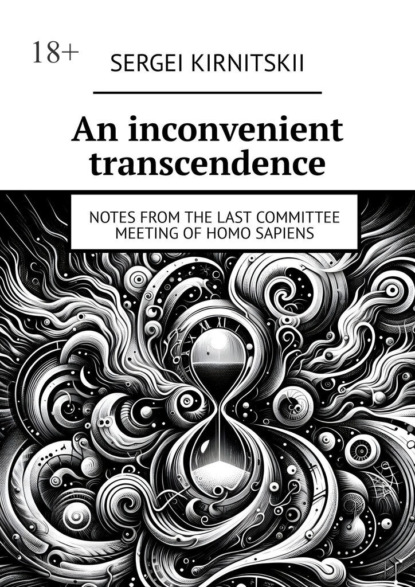An inconvenient transcendence. Notes from the Last Committee Meeting of Homo Sapiens

- -
- 100%
- +
Want to see how quickly «important» becomes «forgotten»? How «this will change the world!» becomes «what was that again?»
Welcome to the Museum of Vanished Truths. Exhibits updated daily. Because the velocity of forgetting grows exponentially. And what seems eternal today becomes archaeology tomorrow.
Remember Al Gore’s «An Inconvenient Truth»? No? Exactly. Yet it was THE MOST IMPORTANT THING of 2006. The film that would change the world. Save the planet. Awaken humanity.
Now it’s a footnote. A line in history. A meme for those who remember. «ManBearPig» from South Park is better remembered than the original.
And this is the fate of all Seldon Plans. All attempts to save the unsaveable. All theatres of salvation.
The curtain falls. The actors exit. The audience disperses. And life continues. Without a plan. Without control. Beautiful in its chaos.
As the Mule would say: «Now let’s see what happens next.» And he’d smile. Because he knew: what comes next will be more interesting than any plan.
Chapter 3: The Archaeology of Disappearances
Remember «An Inconvenient Truth»? No? But this was THE DEFINING MOMENT of 2006. Al Gore, PowerPoint, and planetary salvation. An Oscar! The Nobel Peace Prize! A turning point in human history! The awakening of global consciousness!
Now it seems as absurd as Greta Thunberg handing out flyers on a street corner. «Excuse me, would you like to learn about the climate crisis? I have a pamphlet. And stickers!»
Welcome to the archaeology of cultural oblivion, where yesterday’s revelations are today’s memes, and today’s memes are tomorrow’s void. Where the speed at which «important» becomes «forgotten» has reached the speed of light. And continues accelerating.
3.1. Cultural Amnesia: The «An Inconvenient Truth» Case Study
Let’s trace the lifecycle of a «world-changing» cultural event. Like an anthropologist studying an extinct civilisation. Except the civilisation is us, and the extinction is happening in real-time.
2006: Birth of a Phenomenon
January 2006. Sundance Film Festival. Al Gore takes the stage with a presentation about global warming. The audience: Hollywood elite. Standing ovation. Tears. Revelation. «We must act IMMEDIATELY!»
Picture the scene. The former Vice President of the United States explaining to celebrities via PowerPoint that polar bears are drowning. Leonardo DiCaprio nods sagely. Meryl Streep dabs at a tear. Producers calculate the potential profit margins of environmental conscience.
The film becomes a phenomenon. $50 million at the box office – for a documentary, that’s the equivalent of «Avatar». Everyone’s talking about it. LITERALLY EVERYONE. Impossible to attend a dinner party without hearing: «Have you seen Gore’s film? It changed my life!»
2007: Peak Glory
Oscar for Best Documentary. Al Gore on stage. The world applauds. Ecology is the new religion. PowerPoint, the new scripture. CO₂ graphs, the new tablets from Mount Sinai.
Nobel Peace Prize. Gore shares it with the Intergovernmental Panel on Climate Change. Because nothing promotes peace quite like collective panic about the future.
Bestselling book. Educational programme. Army of volunteers spreading the gospel of greenhouse gases. This is a movement! A revolution! This will change the world forever!
2010: «What was Gore on about again?»
Four years later. «An Inconvenient Truth? Oh yes, I vaguely recall. Something about bears, wasn’t it? Or penguins? Glaciers? Something melting. Something important. I think.»
The film’s still mentioned, but now as history. «Remember when everyone watched that Gore film?» Past tense. As if it happened not four years ago, but in a previous geological era.
The new generation of activists already considers Gore’s approach antiquated. PowerPoint? Seriously? Where are the viral videos? The memes? The TikTok challenges? Grandfather with his graphs – that’s not cool anymore.
2015: The Meme Outlives the Message
South Park creates ManBearPig – a parody of Al Gore and his crusade. Half-man, half-bear, half-pig becomes the symbol of alarmism. «I’m super cereal!» – cartoon Gore’s catchphrase – gets quoted more than anything from the original film.
The irony: parody outlives original. ManBearPig is remembered by those who never saw «An Inconvenient Truth». Meme defeats message. Laughter defeats seriousness. The internet defeats everyone.
South Park’s creators later admit they were wrong. They make an episode where ManBearPig turns out to be real. But it’s too late. The meme has taken on a life of its own. Cultural memory has fixed on the parody, not the original.
2024: Archaeological Artifact
Try finding someone under 25 who’s seen this film. «An Inconvenient what? Is that about IT?»
Mentioning the film in conversation requires explanations. Like referencing a 1983 hit parade. «You know, like in that song… no? Well, it was very popular… in its time… never mind.»
Gore still fights climate change. But now he’s like a Japanese soldier who doesn’t know the war is over. Still fighting while the world has moved on to newer apocalypses.
The Lesson: Even «inconvenient truths» are conveniently forgotten
The film was called «An Inconvenient Truth». The irony is that forgetting proved remarkably convenient. Because remembering is work. And we have new crises. Fresh apocalypses. Hot catastrophes straight from the oven.
The climate crisis hasn’t gone anywhere. It’s actually got worse. But cultural memory of the film that «changed everything» evaporated faster than Arctic ice.
This isn’t a critique of Gore or his film. It’s an observation of how cultural memory works in the age of information obesity. We can’t keep even the apocalypse in focus for longer than one electoral cycle.
3.2. The Speed of Cultural Metabolism: Mongrels and the Boundaries of Acceptability
Now let’s discuss the velocity at which the boundaries of acceptability shift. Take, for instance, the British series «Mongrels» – a puppet show on BBC Three that aired from 2010 to 2011.
2010: Everything’s Fair Game
«Mongrels» was… special. Imagine «The Muppet Show» if the Muppets snorted cocaine, had sex, and made Holocaust jokes. Anthropomorphic animals in an urban setting, exploring the darkest corners of British humour.
A metrosexual fox. A sociopathic pigeon. A cat with anger management issues. And jokes that… well, let’s just say they tested boundaries with the enthusiasm of a kamikaze bomb disposal expert.
BBC Three showed this in prime time. Critics praised its boldness. Viewers either adored or despised it – no middle ground. This was the peak of the «you can joke about anything if it’s funny» era.
2015: «That was a bit much, actually»
Five years later. The series is no longer broadcast. Discussions now feature the phrase «product of its time». Code for «we don’t do that anymore».
The same critics who praised its boldness now write analytical pieces about its problematic nature. «Of course, it was groundbreaking, BUT…» Followed by a list of what’s now considered unacceptable.
The creators begin justifying themselves in interviews. «It was satire!» «We were mocking prejudice!» «Context matters!» But that train has left the station. The Overton window has shifted, and «Mongrels» remains outside.
2020: «How did this ever air?»
A new generation discovers the series. Reaction: shock. «This was on television? On the BBC? The same BBC that now puts warnings before «Fawlty Towers’?»
Social media explodes. Twitter threads about how problematic everything in this series is. Petitions demanding apologies from the BBC. Articles about the «dark past» of British comedy.
The amusing part: the same jokes that were «bold» ten years ago are now «inadmissible». The jokes haven’t changed. We have. Or rather, the boundary has.
2024: Digital Samizdat
Try finding «Mongrels» on legal platforms. Good luck! BBC quietly removed it from iPlayer. Netflix won’t touch it. Amazon Prime pretends it never existed.
The series exists in the digital underground. Torrents. Pirate sites. VPN-only content. From mainstream to underground in 14 years. From BBC to the dark web. Progress!
Fans exchange episodes like Soviet dissidents sharing samizdat. «Do you have the Christmas party episode?» «Shh, not here. Here’s an encrypted link.»
The Phenomenon: The Overton Window Slams Shut Faster Than It Opens
Previously, boundaries of acceptability expanded over decades and narrowed over centuries. Now – they expand over years and contract in months.
1960s: «We can show a kiss in cinema!» (revolution!) 1970s: «We can say «damn’ on television!» (scandal!) 1980s: «We can show violence!» (moral panic!) 1990s: «Anything goes!» (flowering) 2000s: «ANYTHING GOES!» (apex) 2010s: «Anything goes… probably?» (doubt) 2020s: «You may do what’s on the approved list» (rollback)
The pendulum swung back so fast that many didn’t have time to dodge. Yesterday’s comedy revolutionaries are today’s personae non gratae.
3.3. The Acceleration of Forgetting Cycles
Let’s step back from specific examples and examine the bigger picture. The speed at which cultural memory digests and excretes information.
The Degradation of Memory Graph:
Empires: Remembered for Millennia
The Roman Empire fell in 476 AD. We still study Latin, Roman law, use their calendar. 1500+ years and still in cultural memory.
Egyptian pyramids built 4500 years ago. Every schoolchild knows about pharaohs. Hieroglyphics being deciphered. Mummies in museums. Millennia – and not forgotten.
This was the golden age of cultural memory. When the important remained important for centuries.
Ideologies: Remembered for Centuries
Christianity, Islam, Buddhism – religions endure for centuries. Changing slowly but preserving their core.
The Enlightenment – a couple of centuries of active intellectual life. Voltaire, Rousseau, Diderot – still quoted (though increasingly rarely).
Marxism – about 150 years from manifesto to Soviet collapse. A respectable run for an ideology.
Politicians: Remembered for Decades
Churchill, Roosevelt, de Gaulle – remained in active memory for decades after death. Quoted, referenced, invoked.
Thatcher, Reagan – 30—40 years of relevance. Then – historical figures for textbooks.
Clinton, Blair – 20 years, and you already need to remind the young who they were.
Stars: Remembered for Years
The Beatles – an exception, still remembered. But that’s an anomaly.
Spice Girls – 5 years of global fame, then nostalgia for a generation.
One Direction – ruled from 2010 to 2016. Ask a teenager now – they’ll shrug.
Memes: Remembered for Hours
Harlem Shake – February 2013, dead by March 2013.
Ice Bucket Challenge – August 2014, forgotten by October 2014.
Pokémon in Pokemon Go – July 2016, uncool by August.
The latest viral trend? You’ve already forgotten while reading this paragraph.
The Exponential Compression of Cultural Memory
See the pattern? This isn’t linear acceleration. It’s exponential. Each successive generation of phenomena lives exponentially shorter than the previous.
Plot it on a graph, and you get a curve approaching zero. The asymptote of cultural oblivion. The point where the lifespan of a cultural phenomenon equals the time of its creation.
We’re approaching cultural singularity. The moment when things become obsolete faster than we can notice them. When «eternal» and «instantaneous» become synonyms.
3.4. Digital Dementia
And here we arrive at the paradox of our time. We have technology capable of preserving EVERYTHING. Every tweet. Every photo. Every video. Every thought expressed online. Yet we remember LESS than any generation before us.
The Paradox: Everything’s Recorded, Nothing’s Remembered
Google indexes billions of pages. Your 2007 emails are still somewhere in Gmail. Photos from that party in 2012 – in the cloud. Your LiveJournal post from 2005 technically still exists.
But try remembering what you were thinking about last week. What you watched on YouTube yesterday. Which meme you liked an hour ago. Blank?
We live in an era of total documentation and total oblivion. As if you had a perfect library containing every book in the world, but you’d forgotten how to read.
Information Obesity: Too Much to Process
The average American consumes 34GB of information daily. That’s 100,000 words. That’s «War and Peace» every four days. More than a medieval person received in their entire lifetime.
The brain does the only sensible thing in this situation – forgets. Aggressively. Immediately. Totally. Because the alternative is going mad from information overload.
We’re like those Romans at feasts who induced vomiting to continue eating. Only we induce amnesia to consume more content.
Algorithms as the New Memory Censors
Previously, humans decided what to remember. Historians selected the important. Librarians preserved the valuable. Teachers transmitted the essential.
Now algorithms decide. What to show in your feed. What to surface in search. What to recommend for viewing. And their criterion isn’t importance but engagement. Not value but clicks.
The algorithm won’t show you what’s important. It’ll show what you’re likely to click. And we click on cats, scandals, and conspiracy theories. Therefore our cultural memory now consists of cats, scandals, and conspiracy theories.
«That was last year» = «That was in another epoch»
Temporal compression has reached absurdity. Last year’s events seem like ancient history. The pandemic started 4 years ago? Feels like a past life. Brexit was in 2016? That’s the Stone Age!
The younger generation genuinely doesn’t understand how we lived without the internet. For them, it’s like asking how people lived without air. «Seriously, you CALLED to find out if someone was home? Savages!»
Each year now is like a decade before. Each decade like a century. We’re living in history’s fast-forward, where everything becomes retro before it can become classic.
Diagnosis: Collective Alzheimer’s as Adaptation
And you know what? Maybe this isn’t a bug but a feature. Maybe collective forgetting is an evolutionary adaptation to the information explosion.
Imagine if we remembered EVERYTHING. Every Trump tweet. Every celebrity scandal. Every conspiracy theory. Every failed startup. Every broken political promise. We’d go mad from the weight of this information.
Forgetting is the forest ranger of our consciousness. It clears space for the new. Even if the new is recycled old. Even if we’re doomed to repeat forgotten mistakes.
Perhaps humanity is preparing for transition. And mass amnesia is a way to free up RAM for loading a new operating system. Ctrl+Alt+Delete for homo sapiens.
Bridge to Chapter 4: From Amnesia to Anatomy
So, we’re forgetting faster and faster. Cultural memory compresses. The important becomes a meme, the meme becomes nothing. And it’s accelerating.
But perhaps the problem runs deeper? Perhaps it’s not about the speed of information but a fundamental design flaw? In the very structure of humans trying to cope with a world they weren’t designed for?
Time to examine the instruction manual for the «crown of creation». Spoiler: there’s lots of fine print and disclaimers. And the warranty expired long ago.
Humanity is the beta version of a sentient being, launched into production without proper testing. With bugs in the code. With version incompatibility. With critical security vulnerabilities.
And we wonder why nothing works properly? Why things keep breaking? Why the system requires constant rebooting?
Maybe because it’s time to admit: the model is obsolete. Updates no longer help. We need a new version. From scratch. Clean slate. Learning from the previous version’s errors.
But first – let’s take an honest look at the current model. All its design features. All its factory defects. All the workarounds we use to compensate for inherent flaws.
Welcome to the homo sapiens service centre. Diagnosis is free. Repairs… well, repairs are complicated. Because some things can’t be fixed. They must be replaced entirely.
And the funniest part? We know this. Deep down, beneath all the layers of cultural amnesia, we know the expiration date is approaching. That it’s time for an upgrade. That the old model can’t handle it anymore.
But we keep pretending everything’s fine. That it’ll last a bit longer. That we can patch it up and keep going.
Like those Lada owners who spend years assembling their car from spare parts instead of admitting: time to buy a new one. Only in our case, the Lada is humanity, and the new car is what we’ll become.
If we survive the transformation. But that’s another story entirely.
PART II: ANATOMY OF INADEQUACY
Chapter 4. Assembly Instructions for the Crown of Creation
God needed six days to create the world and mankind. Mankind needs a 40-page manual to assemble an IKEA wardrobe. And we’ll still get it wrong. There will be leftover parts. The doors will open the wrong way. And somewhere in the process, we’ll definitely injure ourselves on that tiny piece the instructions warned about: «Caution: sharp edges.»
If we extrapolate this proportion, properly assembling and operating a human would require an instruction manual the size of the Library of Congress. But the Creator, apparently, was a minimalist. Or ran out of ink. Or – and this is the most plausible version – decided: «They’ll figure it out somehow.»
Spoiler: we didn’t.
4.1. Catalogue of Design Defects
Let’s conduct an honest MOT test on the crown of creation. No sugar-coating. As if humanity were a used car undergoing pre-purchase inspection. Spoiler: it wouldn’t make it off the lot.
The Spine: An Engineering Nightmare
Let’s start with the foundation – the vertebral column. This construction is perfectly suited for a creature moving on four limbs. Imagine a bridge – when horizontal, the load distributes evenly. Now stand that bridge vertically. Congratulations, you’ve just invented lumbago.
Eighty percent of humans experience back pain. Eighty percent! This isn’t a side effect – it’s a key feature. If 80% of car owners experienced breakdowns, the model would be recalled. But you can’t recall humanity. Best we can do is prescribe painkillers.
Evolution: «Right, apes, stand up on your hind legs!» Spine: «Er, excuse me, I wasn’t designed for this…» Evolution: «You’ll adapt!» Narrator: «They did not, in fact, adapt.»
The Brain: Too Big and Too Small Simultaneously
The human brain is a paradox. Too large for childbirth (hello, pre-modern maternal mortality rates). Too small for the tasks we’ve assigned it (try visualising four-dimensional space – I’ll wait).
We’re born premature by mammalian standards. A foal stands and runs within an hour of birth. A human infant can’t even hold its head up. Because if the brain fully developed in utero, birth would be impossible.
Evolution’s solution? «Birth them half-baked, finish cooking later!» It’s like releasing smartphones with incomplete operating systems. «Updates will arrive over the next 18 years. Expect crashes. Especially during the teenage firmware update.»
The Psyche: Configured for 150 People, Living Among Millions
Dunbar’s number – 150. That’s the cognitive limit for stable social relationships a human can maintain. Our brains evolved for tribal life. Everyone knows everyone. Everything’s connected. Simple.
Now check your phone contacts. Social network «friends’ (remember fifty from your five hundred?). LinkedIn connections. Followers and followings. We’re trying to force an ocean of social connections into a glass designed for a village puddle.
The result? Social anxiety as factory setting. Loneliness in crowds. Choice paralysis from 200 unread messages demanding prioritisation. Imposter syndrome, because we’re constantly among strangers, pretending we know what we’re doing. (Narrator: We don’t.)
Lifespan: Bug or Feature?
Too short for accumulating wisdom. Just when you start understanding things, the machinery starts falling apart. «Oh, I finally understand how to live! Oh, what was that cracking sound?»
Too long for maintaining enthusiasm. First 25 years – loading tutorial. Next 40 – grinding the main quest. Final 20 – trying to remember why we started playing.
Nature calculated for 30—40 years. Have children, pass on genes, exit stage left. But we hacked the system with medicine. Now we live twice the intended runtime. Like Windows 95 forced to run on modern hardware. It works, but everything’s constantly glitching.
Digestive System: Optimised for Scarcity, Operating in Abundance
Our organisms evolved under constant starvation threat. See calories? Grab them! Store them! Fat equals survival!
Now we live in a world where pizza delivery arrives at 3 AM. Where ten fast-food restaurants occupy every square kilometre. Where sugar costs less than water.
Body: «Oh, calories! Emergency storage protocol activated!» Human: «I was just bored…» Body: «STORING! What if we don’t catch a mammoth tomorrow?» Human: «What mammoth? My fridge is packed!» Body: «IRRELEVANT! STORING PROTOCOLS ENGAGED!»
Verdict: Beta Version Deployed to Production
If humanity were software: – Version: 0.7.3 (beta) – Status: Not recommended for production environment – Known bugs: See appendix (volume 1 of 47) – Patches: Unavailable, source code lost – Support: Discontinued
But here we are in production. Eight billion instances of a beta version, attempting to fix crashes with civilisation’s duct tape. And wondering why everything keeps crashing.
4.2. Civilisation as a System of Workarounds
If humanity is buggy beta software, then civilisation is a collection of patches, workarounds, and creative kludges. We don’t fix problems – we route around them. Creatively. Inventively. Absurdly.
Clothing: Compensating for Fur Loss
Somewhere in Africa, our ancestors decided: «Let’s lose the fur! We’ll be cool naked apes!» Evolution: «Fine, but consider – » Ancestors: «Too late, already shed it!»
Fast-forward a few million years. A human stands in a shop, choosing between a £500 down jacket and an £800 down jacket. Both filled with bird feathers. Birds, incidentally, being dinosaur descendants. Who went extinct. The irony writes itself.
We’ve created an entire industry around our lack of fur. Fashion, brands, seasonal collections. «This sheep’s wool costs a thousand pounds because it has a logo!» The sheep remains unconvinced.
Houses: Compensating for Lost Shelter Instincts
Animals know where and how to build shelters. It’s pre-installed. Beavers don’t attend courses on «Dam Construction for Beginners». Birds don’t Google «nest building tutorial step by step with pictures».
Humans? Humans hire architects, designers, contractors, subcontractors. Take out 30-year mortgages. Argue about bathroom tile colours. And ultimately live in boxes distinguished from other boxes solely by their numbers.
From cave to skyscraper – the evolution of dwelling. But the essence remains: we’re cold, wet, and frightened. Only now we pay £2,000 monthly for the privilege. In Manhattan, £5,000. For the same feeling of security a cave-dweller got for free.
Laws: Compensating for Lost Instincts
Animals have built-in behavioural firmware. Don’t kill your pack. Don’t eat the young. Share food. Simple, clear, functional.





